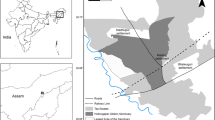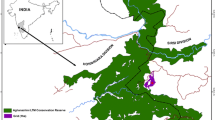Abstract
I studied long- tailed macaque (Macaca fascicularis)feeding behavior and ecology as part of a larger behavioral ecological study at the Natai Lengkuas Station, Tanjung Puting National Park, Kalimantan Tengah, Indonesia. I collected data on feeding behavior via scan sampling of all visible individuals in the focal group (approximately 800 observation hours). I established vegetational plots and monitored them monthly to determine food availability and abundance. I found long- tailed macaques to be primarily frugivorous;leaves, flowers, insects and bark provided the remainder of the diet. They used at least 33 plant species as food sources, but >60% of the diet was provided by only 5 species. Based on previous vegetational analyses, these tree species were among the highest in relative density. However, selection ratios for 19 food species indicate that 13 of them were selected more often than expected. Long- tailed macaques appear to be selective feeders but can exploit a variety of food sources during periods of food scarcity.
Similar content being viewed by others
References
Bauchop, T. (1978). Digestion of leaves in vertebrate arboreal folivores. In Montgomery, G. G. (ed.),The Ecology of Arboreal Folivores, Smithsonian Institution, Washington, DC, pp. 193–204.
Bauchop, T., and Martucci, R. W. (1968). Ruminant-like digestion of the langur monkey.Science 161: 698–700.
Berenstain, L. (1986). Responses of long-tailed macaques to drought and fire in Eastern Borneo: A preliminary report.Biotropica 18: 257–262.
Caldecott, J. O. (1986),An Ecological and Behavioural Study of the Pig-Tailed Macaque, Karger, Basel.
Choo, G. M., Waterman, P. G., McKey, D. B., and Gartlan, J. S. (1981). A simple enzyme assay for dry matter digestibility and its value in studying food selection by generalist herbivores.Oecologia 49: 170–178.
Clutton-Brock, T. H. (1975). Feeding behaviour of red colobus and black and white colobus in East Africa.Fol. Primatol. 23: 165–207.
Collins, L., and Roberts, M. (1978). Arboreal folivores in captivity—maintenance of a delicate minority. In Montgomery, G. G. (ed.),The Ecology of Arboreal Folivores, Smithsonian Institution, Washington, DC, pp. 5–12.
Fittinghoff, N. A., and Lindburg, D. G. (1980). Riverine refuging in East BorneanMacaca fascicularis. In Lindburg, D. (ed.),The Macaques: Studies in Ecology, Behavior and Evolution, Van Nostrand Reinhold, New York, pp. 182–213.
Hladik, C. M. (1977). A comparative study of the feeding strategies of two sympatric species of leaf monkey:Presbytis senex andPresbytis entellus. In Clutton-Brock, T. H. (ed.),Primate Ecology, Academic Press, Cambridge, pp. 31–37.
Hock, L. B., and Sasekumar, A. (1979). A preliminary study on the feeding biology of mangrove forest primates, Kuala Selangor.Mal. Nat. J. 33: 105–112.
Kurland, J. A. (1973). A natural history of kra macaques(Macaca fascicularis RAFFLES, 1821) at the Kutai Reserve, Kalimantan Timur, Indonesia.Primates 14: 245–262.
Lucas, P. W., and Corlett, R. T. (1991). Relationship between the diet ofMacaca fascicularis and forest phenology.Folia Primatol. 57: 201–215.
McKey, D. B., Gartlan, J. S., Waterman, P. G., and Choo, G. M. (1981). Food selection by black colobus monkeys(Colobus salarias) in relation to plant chemistry.Biol. J. Linn. Soc. 16: 115–146.
Milton, K. (1979). Factors influencing leaf choice by howler monkeys: A test of some hypotheses of food selection by generalist herbivores.Am. Nat. 114: 362–378.
Mueller-Dombois, D., and Euenberg, H. (1974),Aims and Methods of Vegetation Ecology, Wiley and Sons, New York.
Pielou, E. C. (1966). Shannon's formula as a measure of specific diversity: Its use and misuses.Am. Nat. 104: 463–465.
Rhoades, D. F., and Cates, R. G. (1976). Toward a general theory of plant anti-herbivore chemistry. In Wallace, J., and Mansell, R. (eds.),Biochemical Interactions Between Plants and Insects, Vol 10, Plenum Press, New York.
Rodman, P. S. (1978). Diets, densities and distributions of Bornean primates. In Montgomery, G. G. (ed.),The Ecology of Arboreal Folivores, Smithsonian Institution, Washington, DC, pp. 465–478.
Schoener, T. W. (1982). The controversy over interspecific competition.Am. Sci. 70: 586–595.
Sussman, R. W., and Tattersall, I. (1981). Behavior and ecology ofMacaca fascicularis in Mauritius: A preliminary study.Primates 22: 192–205.
van Schaik, C. P., van Noordwijk, M. A., de Boer, R. J., and den Tonkelaar, I. (1983). The effect of group size on time budgets and social behaviour in wild long-tailed macaques(Macaca fascicularis).Behav. Ecol Sociobiol. 13: 173–181.
Waser, P. M. (1987). Interactions among primate species. In Smuts, B. B., Cheney, D. L., Seyfarth, R. M., Wrangham, R. W., and Struhsaker, T. T. (eds.),Primate Societies, University of Chicago Press, Chicago, pp. 210–226.
Waterman, P. G. (1984). Food acquisition and processing as a function of plant chemistry. In Chivers, D. J., Wood, B. A., and Bilsborough, A. (eds.),Food Acquisition and Processing in Primates, Plenum Press, New York, pp. 177–211.
Waterman, P. G., Ross, J. A. M., Bennett, E. L., and Davies, A. G.(1988). A comparison of the floristics and leaf chemistry of the tree flora in two Malaysian rainforests and the influence of leaf chemistry on populations of colobine monkeys in the Old World.Biol. J. Linn. Soc. 34: 1–32.
Wheatley, B. P. (1978). The Behavior and Ecology of the Crab-Eating Macaque (Macaca fascicularis.) in the Kutai Nature Reserve, East Kalimantan, Indonesia, Ph.D. dissertation, University of California—Davis, Davis.
Wheatley, B. P. (1980). Feeding and ranging of East BorneanMacaca fascicularis. In Linburg, D. (ed.),The Macaques: Studies in Ecology, Behavior and Evolution, Van Nostrand Reinhold: New York, pp. 215–246.
Yeager, C. P. (1989). Feeding behavior and ecology of the proboscis monkey(Nasalis larvatus).Int. J. Primatol. 10: 497–530.
Author information
Authors and Affiliations
Rights and permissions
About this article
Cite this article
Yeager, C.P. Feeding ecology of the long-tailed macaque(Macaca fascicularis) in Kalimantan Tengah, Indonesia. International Journal of Primatology 17, 51–62 (1996). https://doi.org/10.1007/BF02696158
Received:
Accepted:
Issue Date:
DOI: https://doi.org/10.1007/BF02696158




